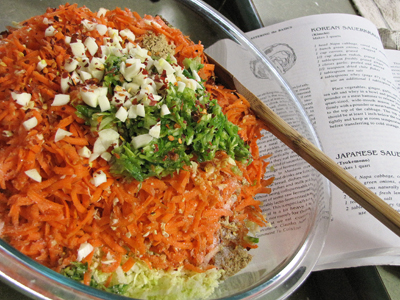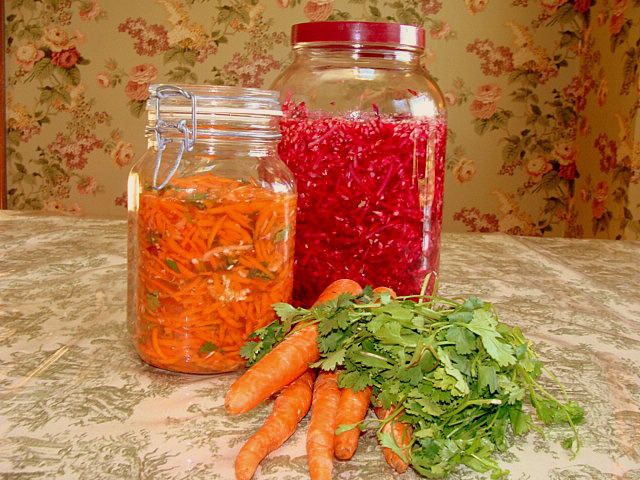Cortido is another one of my favorite sauerkrauts! I just fermented a couple of quarts so I thought I’d share my recipe with you. There’s just something about the combo of onion, oregano, and red pepper flakes that’s really unique! If you’ve never had anything like it, you’re just going to have to trust me and try it. My recipe is adapted from the classic traditional foods cookbook Nourishing Traditions.
Cut the core out of the cabbage and cut it in to chunks that will fit in your food processor, if using one.
Shred the cabbage in a food processor with the slicing disc (or you can chop it with a knife).
Grate the carrots.
Slice the onion.
Mix all the veggies in a deep bowl with the oregano, red pepper flakes, and salt.
Pound it for 10 minutes with a kraut pounder, meat tenderizer, large pestle, or just by squeeze it with your hands (you might want to wear gloves because of the red pepper flakes).
This will pull some water from the cabbage to make a brine.
Place the cabbage mixture and brine into quart jars leaving at least an inch of space at the top.
If you don’t have enough brine to cover all the cabbage, add filtered water to the jar until it’s covered.
Place the lid on the jar and leave it on the counter to ferment.
Check it after 3 days and see how it tastes, if it’s to your liking put it in the fridge, if not, close it back up and check again in a couple of days.
Make sure you check the jars every couple of days and release some of the gases that build up. If you forget about it long enough your jar will explode. Then you’ll never make that mistake again!
Store the finished sauerkraut in the fridge.
Editor’s Note: I highly recommend purchasing Fido jars for fermenting as their special lids allow for Co2 to escape while also keeping O2 out. They also are not prone to exploding like regular canning jars. Plus, the lids are glass with a rubber seal! Other great options are the Pickl-It Jars and Harsch crocks.
So far, this is my very favorite flavor of sauerkraut!
This recipe is based on a kraut we were purchasing regularly and spending way too much money on, so I decided to figure out how to make it myself. My favorite ways to use this kraut is with hot dogs, on fried eggs, stuffed into half an avocado, and as a salad dressing.
Cut the core out of the cabbage and cut it in to chunks that will fit in your food processor, if using one
Shred the cabbage in a food processor with the slicing disc (or you can chop it with a knife)
Put it in a deep bowl with the cumin, caraway, and salt
Pound it for 10 minutes with a kraut pounder, meat tenderizer, or large pestle (or just by squeeze it with your hands)
This will pull some water from the cabbage to make a brine
Place the cabbage mixture and brine into quart jars leaving at least an inch of space at the top
If you don’t have enough brine to cover all the cabbage, add filtered water to the jar until it’s covered
Place the lid on the jar and leave it on the counter to ferment
Check it after 3 days and see how it tastes, if it’s to your liking put it in the fridge, if not, close it back up and check again in a couple of days
Make sure you check the jars every couple of days and release some of the gases that build up. If you forget about it long enough your jar will explode. Then you’ll never make that mistake again!
Store the finished sauerkraut in the fridge
An aromatic blend of spices with shredded carrots, this tastes good fermented or not.
Shred carrots either with a grater or in a food processor. Place in a large non-reactive bowl and add remaining ingredients. Mix well and let rest for about 15 mins. by now the salt should have released the juices from the carrots. You can mash it a bit with a kraut pounder, wooden spoon or just squeeze in your hands. Spoon into a mason jar or fermentation vessel, pressing down so the carrots are submerged in their juices. Use a weight to keep the carrot submerged. Cover and let set at room temperature for about 5 days.
Here is the way this extremely nourishing condiment was traditionally prepared, lacto-fermented style. This is a raw recipe that is chock full of enzymes that aid in digestion and the immune system. Cabbage is an amazing superfood that provides a lot of vitamin C, fiber, and is rich in cancer-inhibiting elements. Eating cabbage in the form of raw, lacto-fermented sauerkraut is probably the most nutrient dense way to prepare it, in my opinion.
Toss your cabbage in a bowl and add the caraway seeds.
Now add the sea salt and whey.
Pound it all with a wooden pounder or a meat hammer for 10 minutes.
Now stick it all in a quart-sized wide-mouthed jar and press it down really well until the juices cover the top. I found that a ladle did the trick for this part.
There should be at least one inch above the cabbage and the top of the jar.
Cover tightly and keep it at room temperature for about 3 days, then store it in the fridge. You’ll notice the flavor improves the longer it’s been stored. I wish more foods were like this…
An easy and delicious version of Korean Kimchee. This dish will keep indefinitely in your refrigerator after the initial fermentation. All the veggies I use in this dish are organically grown.
Prepare all the vegetables and put them into a very large bowl, crock or food safe bucket, or more than one container if you need to in order to have enough room.
When you add the cabbage, do it in layers, adding the salt as you go.
Pound and mix the vegetables until it is very juicy.
Pack firmly into a gallon-sized glass jar.
Cover with cabbage leaves held down by clean rocks. The vegetables need to be kept below the liquid that rises to protect them from the air and spoilage. You can also use a food storage bag filled with water, and sealed tightly to hold the vegetables down. I would double bag the water, to be safe.
Cover jar. Let sit at room temperature, venting the jar occasionally, for 3 days. Then refrigerate.
When you are ready to eat some, either right away or after a week or two, remove the rocks and cabbage leaves and enjoy! Once it is refrigerated, you needn’t worry about it spoiling and can leave off the cabbage leaves.
Colorful and tasty and just a bit spicy, this is a kraut sure to please.

Chop/shred cabbage, carrots, green onions, ginger and garlic by hand or with a food processor. Combine all ingredients in a medium size mixing bowl. Cover with a tea towel and leave to sit at room temperature for 1/2 hour while the salt helps pull the juices out of the veggies.
Pound a few times with a potato masher or meat hammer (or kraut pounder) to make sure it is getting juicy. Leave for another 1/2 hour if desired, or proceed.
Transfer ingredients to a clean quart-size, wide mouth jar. Press down firmly so that liquid comes to the top of the mixture. Leave 1” space at the top of the jar. Put on lid and band and screw tightly.
Allow to ferment at room temperature for three to seven days. In the first 24 hours, open the jar and press down firmly on the ingredients a few times to make sure the brine is fully covering the mixture (it will continue to be released over time).
Fermentation may proceed faster at very warm temperatures. Burp jar daily, even keeping the jar on a towel to catch seeping liquids. Skim off any mold or fuzz that develops on top (everything beneath the brine should be fine).
The mixture will be bubbly, and the vegetables will soften. Stop the fermentation when you like the flavor and texture. (We like ours best at 5 to 7 days.) Transfer to the refrigerator or cool storage. Repack carefully each time you serve. Will keep several weeks in the refrigerator.
Serve alongside main dish chicken, turkey, beef, or ham. Serve with eggs for breakfast. Enjoy!
This is one of the first recipes for cultured vegetables my family would eat. If you haven’t had golden beets you are in for a treat. I think they taste like sunshine!

Add culture package to a glass gallon jar according to instructions. ( I just place starter in a cup, feed it about 1 tsp. sugar to wake it up and add 1/2 cup of water. Stir till dissolved. Then let it sit while I chop my vegetables ) Or you can add 1/2 cup of kefir whey instead.
Peel and shred all items and place in jar.
Fill with water and cap jar. Let sit for 6 days on your counter out of the sunlight.
Place in refrigerator. They will ferment in the fridge too and taste even better. Cultured veggies last at least 9 months or longer in your fridge.

